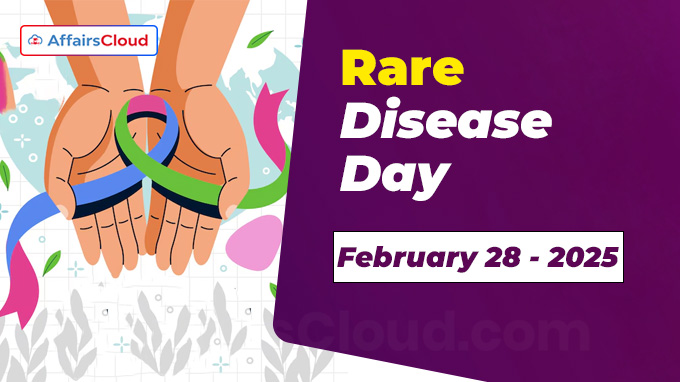
Rare Disease Day is observed annually across the globe on the last day of February, either 28 or 29 in leap years (the rarest day of the year), to raise awareness for the people impacted by rare diseases and unite individuals from over 100 nations. This day also aims to build a community and promote the need for healthcare equity, better access to treatments, and enhanced medical research for those living with rare conditions.
- Rare Disease Day 2025, observed on 28 February 2025, marks the observance of 18th Rare Disease Day.
- The 2025 theme of Rare Disease Day, “More than you can imagine; an anthology of rare experiences,” highlights the challenges, resilience, and experiences of people living with rare diseases.
Note: There is no officially declared theme for Rare Disease Day 2025, but “More than you can imagine; an anthology of rare experiences” is widely mentioned on news sites.
Background:
i. Rare Disease Day was introduced in 2008 by the European Organisation for Rare Diseases (EURORDIS)-Rare Diseases Europe and its Council of National Alliances (CNA).
- The first-ever Rare Disease Day was observed in 2008, with events held in 18 countries.
ii.Since then, Rare Disease Day has grown to include events in over 100 countries.
iii.The goal of this day is to raise awareness about rare diseases, which impact 1 in 20 people worldwide, while promoting unity and advocating for improved representation, support, and care for patients, families, and caregivers.
Why February 29?
February 29 was chosen as the date for Rare Disease Day because it is a rare day that only happens once every 4 years, symbolizing the rarity of the diseases it aims to highlight.
What is a Rare Disease?
i.A rare disease refers to a condition that affects a small proportion of the population. While definitions vary, a disease is often classified as “rare” if it affects fewer than 1 in 2,000 individuals.
ii.These diseases can have a profound impact on those affected and their families, often with limited available treatments or support.
Points to Note:
i.According to the World Health Organization (WHO), the classification of a rare disease is based on its epidemiology, with the frequency of such diseases being less than 6.5-10 per 10,000 individuals.
- Over 6,000 different rare diseases have been identified, with more than 300 million people worldwide living with one.
- Additionally, 72% of rare diseases are genetic, and almost one in 5 cancers is classified as rare. Furthermore, 70% of these rare genetic diseases begin during childhood.
ii.In India, the Non-Profit Organization (NPO), Organization for Rare Diseases India (ORDI) has been established to advocate for individuals with rare diseases.
iii.Considering India’s large population, ORDI defines a disease as rare if it affects one in every 5,000 people or fewer. ORDI has identified 263 rare diseases in India. The top 5 of these are:
- Acanthocytosis Chorea – A neurological disorder affecting movement in various body parts.
- Achalasia Cardia – A rare condition causing difficulty in swallowing, affecting the esophagus.
- Acromesomelic Dysplasia – A skeletal disorder, also known as short-limb dwarfism, leading to short stature.
- Acute Inflammatory Demyelinating Polyneuropathy (AIDP) – A condition affecting the nervous system, causing inflammation and damage to nerve cells.
- Acute Lymphoblastic Leukaemia (ALL) – A blood cancer that primarily affects white blood cells.
About EURORDIS-Rare Diseases Europe:
EURORDIS-Rare Diseases Europe is a non-governmental, Non-Profit Alliance (NPA) consisting of over 1,000 rare disease patient organizations from 74 countries and individuals engaged in Europe’s rare disease community.
Chief Executive Officer(CEO) -Virginie Bros-Facer
Headquarters – Paris, France
Established – 1997




